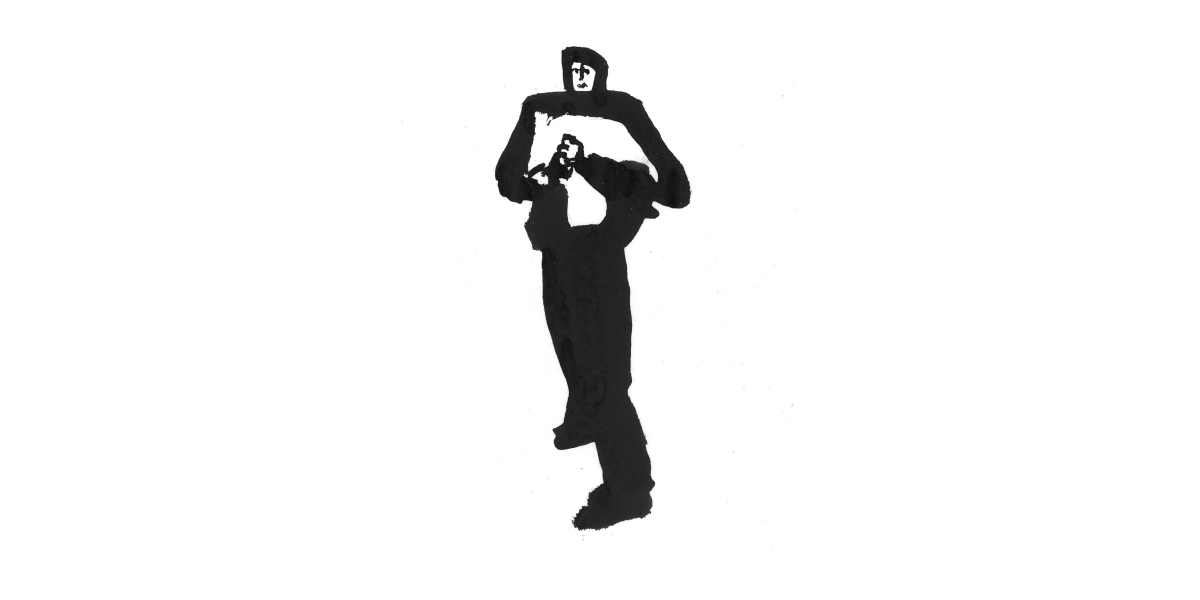My dad grew up playing sandlot baseball in Middletown, New York. (I don’t really know what a sandlot is but it occupies the same space in my imagination as a soda jerk.) For some reason, he never communicated this passion to his kids. Sometimes, in picnic weather, he dragged us out to the park carrying softball, bat and mitts. It was a sort of equal opportunity family occasion, effortful (carrying the gear, finding the space, setting up the bases) and not totally satisfying, because you didn’t really win or lose and spent most of the time waiting for another turn.
Once, playing catcher, I stood too close to home plate and my sister’s backswing caught me in the eye socket. Maybe I was five years old. We were living in London at the time and my father scooped me up in his arms and ran to the nearest hospital—about ten blocks away. For years I still had the little leather shoes that fat drops of blood from my forehead had fallen on to and stained.
We got more into cricket. For my dad, baseball had been a way of feeling like part of the country, and we spent enough time in England as kids (about five years) that cricket played the same role for us. It needed even more gear: stumps, bails, batting gloves, flat bats and linseed oil. And whites—the traditional cream-coloured trousers and shirts—though we never bought those because none of us ever played on a real team. We just messed around in the backyard. Cricket has the advantage that the strike zone is a real thing, it’s made of the stumps and the bails, so getting someone out involves indisputable empirical evidence—leather knocking against wood, little sticks falling off and other sticks standing crooked in the ground.
The balls are especially beautiful, deep red. Cricketers in the field pass the ball among themselves between plays and rub the shine off one side against their white trousers, which acquire a pink stain as the afternoon wears on. They do it to create a rough surface, which might make the ball swing in mid-air. Or reverse swing—the idea is the same as a spitball. But it also seems to involve a kind of ritual pleasure. You’re standing around in the outfield doing nothing much, and someone tosses you the ball. You give it a few hard rubs against your thigh, like scratching a dog, and send it along. Games can take all day; you need something to do.
My son plays now; he even owns whites. I still live in London, and a twenty-minute walk from our house can take you through an implausible number of cricket clubs. Implausible because of London real-estate prices, and a cricket club requires a large expanse of beautifully maintained lawn— not to mention a decent pavilion or clubhouse, which includes the dressing rooms and bar. On Friday evenings in spring and summer, the quiet neighbourhood streets around the grounds are jammed with cars, parents dropping off or picking up. There’s a barbecue rota, and people buy home-burnt hamburgers from the grill and beers from the clubhouse and sit around and watch whatever there is to watch—a bunch of kids running after a ball, and sometimes hitting it with a flat stick.
It still doesn’t seem to me like a real sport. The sports I played competitively, soccer and basketball, involve almost constant motion. You can always try harder, and trying harder means not just concentrating more but running until it hurts. Cricket involves a lot of standing around. You pay attention to the weather; you pay attention to the condition of the field. Batsmen between pitches (that’s not what they call them) will stamp out cracks or bend down and pick up a bit of grit from the ground surface, which might affect the bounce of the ball. Like my dad seeing a crumb of cookie on the carpet. It’s like golf in that respect, or sailing: sports that require you to attend to or be in tune with nature.
The language of cricket commentary is typically English, vague-sounding and intuitional. The ball is ‘doing something’ if it swings a little in the air; the pitch has ‘a bit about it’ if a spin bowler can get the ball to grip and turn. Some of it also sounds like code, the kind of code kids would make up for a secret club. Field positions include gully, third slip, backward point and silly mid-on. There are also words for the different kinds of shot or stroke and ways of swinging the bat: square cuts, cover drives, reverse sweeps. It seems like half the pleasure, from the spectator’s point of view, comes from being in the club and knowing the code.
Playing in a match isn’t all that different from watching one. An editor I know once invited me to ‘turn out’ for his village team, so I drove one morning to the Essex countryside and parked by the green. A street actually ran through the outfield; players sometimes had to wait for cars to pass. Various locals showed up to make a day of it, spread picnic blankets out and unwrapped sandwiches and opened thermoses of tea. Our team was batting first and since I was pencilled in as a ‘tailender’ (someone who bats only when everybody else has gotten out), I spent the morning sitting on the picnic blankets, eating the sandwiches and drinking the tea. At a certain point after lunch it was my turn to bat. So I walked out into the middle of the green, faced a few balls, got out, and walked back to the picnic blankets.
There’s a radio show called Test Match Special, which makes good summer-afternoon listening, pleasant background noise for housework, cooking or napping. Since a test match takes all day, the show has to fill the hours, and the commentators spend as much time talking about the cakes they’ve been sent by avid listeners as the game in hand. They remember old matches and josh each other in a partisan way; most are former players. But they talk tactics, too. Cricket is one of the few team sports where the captain makes real-time significant decisions on the field of play. Cricket, like everything else, has been infiltrated by analytics, but the data is open-ended enough and complicated by so many hard-to-predict factors, like weather forecasts, that conversations about strategy remain conversations about intuitions, feelings and long memories.
‘Cricket, like everything else, has been infiltrated by analytics, but the data is open-ended enough and complicated by so many hard-to-predict factors, like weather forecasts, that conversations about strategy remain conversations about intuitions, feelings and long memories.’
Even for old pros, the game seems to retain an air of childish messing around—you’ve got a ball, you’ve got some sticks, you’ve got a bit of grass, let’s see what we can come up with. What if you threw it like that, and I hit it like this . . . That’s the sense I get, watching my son play. One of his favourite picture books (and the one I liked to read to him most) was the Quentin Blake story How Tom Beat Captain Najork and His Hired Sportsmen. A boy, Tom, is being raised by an iron-hatted aunt and spends his days playing outside, with sticks and mud and bits of broken wire, until his aunt decides to lick him into shape. She asks Captain Najork and his hired sportsmen to teach him a lesson, and the captain shows up and proposes various contests to establish his superiority. The trouble is, all these contests involve the kinds of thing that Tom is good at— sliding around, balancing things on other things, playing with sticks. He wins every time, hands down. That’ll teach you not to fool around, he says, with a boy who knows how to fool around. You learn the same kind of thing playing cricket.

